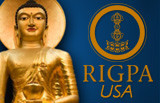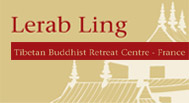History of Rigpa
Today many people around the world have encountered Tibetan Buddhism, and derived enormous benefit from its teachings and practice. One of the direct causes for its remarkable spread was the arrival in the west in the 1960’s and 1970’s of a number of Tibetan teachers, who devoted themselves to discovering how their ancient Buddhist tradition could be placed within the reach of modern men and women.
Among these teachers was Sogyal Rinpoche, and the vehicle that he created to convey the Buddhist teachings was Rigpa. The history of Rigpa, then, is part of the history of how the Buddhadharma came to the west. It is a story that explains what led from a small upstairs room in London where Rinpoche taught a dozen students, to an international organization, with four retreat facilities, a string of city centers and thousands of students, which has played a major part in presenting Tibetan Buddhism to the modern world.

![]() Born in Kham in eastern Tibet, Rinpoche was recognized and enthroned as the incarnation of Lerab Lingpa Tertön Sogyal by Jamyang Khyentse Chökyi Lodrö, one of the most outstanding masters of the twentieth century. Jamyang Khyentse supervised his training and raised him as a son. When conditions deteriorated in Kham, Khyentse Rinpoche and his young disciple left for Central Tibet and Lhasa, where in 1955, for the first time, they met His Holiness the Dalai Lama. They then continued to India on pilgrimage, and Jamyang Khyentse finally settled in Gangtok at the invitation of the Chögyal—the king—of Sikkim. It was there that he passed away in 1959.
Born in Kham in eastern Tibet, Rinpoche was recognized and enthroned as the incarnation of Lerab Lingpa Tertön Sogyal by Jamyang Khyentse Chökyi Lodrö, one of the most outstanding masters of the twentieth century. Jamyang Khyentse supervised his training and raised him as a son. When conditions deteriorated in Kham, Khyentse Rinpoche and his young disciple left for Central Tibet and Lhasa, where in 1955, for the first time, they met His Holiness the Dalai Lama. They then continued to India on pilgrimage, and Jamyang Khyentse finally settled in Gangtok at the invitation of the Chögyal—the king—of Sikkim. It was there that he passed away in 1959.





